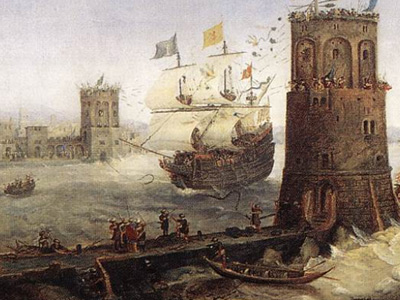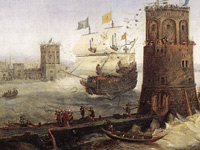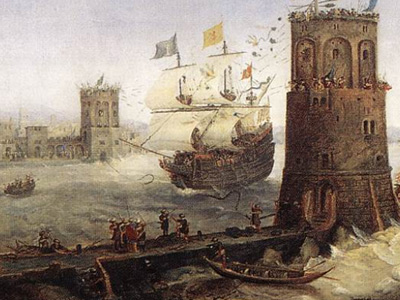Fifth Crusade (1213–1221)

Preparations
Pope Innocent III had already planned since 1208 a crusade to recapture Jerusalem. In April 1213 he issued the papal bull Quia maior, calling all of Christendom to join a new crusade. This was followed by another papal bull, the Ad Liberandam in 1215.
France
The message of the crusade was preached in France The Kingdom of France is the historiographical name or umbrella term given to various political entities of France in the medieval and early modern period. It was one of the most powerful states in Europe since the High Middle Ages. It was also an early colonial power, with possessions around the world. Colonial conflicts with Great Britain led to the loss of much of its North American holdings by 1763. The Kingdom of France adopted a written constitution in 1791, but the Kingdom was abolished a year later and replaced with the First French Republic. by Robert of Courçon; unlike other Crusades, few French knights joined, as they were already fighting the Albigensian Crusade against the heretical Cathar sect in southern France.
The Kingdom of France is the historiographical name or umbrella term given to various political entities of France in the medieval and early modern period. It was one of the most powerful states in Europe since the High Middle Ages. It was also an early colonial power, with possessions around the world. Colonial conflicts with Great Britain led to the loss of much of its North American holdings by 1763. The Kingdom of France adopted a written constitution in 1791, but the Kingdom was abolished a year later and replaced with the First French Republic. by Robert of Courçon; unlike other Crusades, few French knights joined, as they were already fighting the Albigensian Crusade against the heretical Cathar sect in southern France.
In 1215 Pope Innocent III summoned the Fourth Lateran Council, where, along with the Latin Patriarch of Jerusalem, Raoul of Merencourt, he discussed the recovery of the Holy Land, among other church business. Pope Innocent wanted it to be led by the papacy, as the First Crusade should have been, to avoid the mistakes of the Fourth Crusade, which had been taken over by the Venetians. Pope Innocent planned for the crusaders to meet at Brindisi in 1216, and prohibited trade with the Muslims, to ensure that the crusaders would have ships and weapons. Every crusader would receive an indulgence, including those who simply helped pay the expenses of a crusader, but did not go on crusade themselves.
Advertisement

These books are available for download with iBooks on your Mac or iOS device, and with iTunes on your computer. Books can be read with iBooks on your Mac or iOS device.

These books are available for download with iBooks on your Mac or iOS device, and with iTunes on your computer. Books can be read with iBooks on your Mac or iOS device.
( Click image to enlarge)
Hungary and Germany
Oliver of Cologne had preached the crusade in Germany, and Emperor Frederick II attempted to join in 1215. Frederick was the last monarch Innocent wanted to join, as he had challenged the Papacy (and would do so in the years to come). Innocent died in 1216 and was succeeded by Pope Honorius III, who barred Frederick from participating, but organized crusading armies led by King Andrew II of Hungary and Leopold VI, Duke of Austria. Andrew had the largest royal army in the history of the crusades (20,000 knights and 12,000 castle-garrisons).
Georgia
Pope Innocent had managed to secure Georgia's participation in the crusade. Georgia's largely isolationist policies had allowed it to accumulate a powerful army and a very large concentration of knights. However, the reconnaissance force under the Mongols Jebe and Subutai destroyed the entire Georgian army in two successive battles, most notably the battle of Caucausus Mountain. After the death of Georgian King George IV Lasha, his sister Queen Rusudan wrote to the Pope informing him that Georgia was unable to fulfill its promise to assist in the Crusade because its army had been destroyed by unknown savages. It has been speculated that the oddly passive behavior of the Crusaders in the later years was due to them waiting for the Georgian army to join the fray.
Decades after this Crusade, Mongol ruler Hulegu Khan would take a census of the Kingdom of Georgia to ascertain how many troops it could muster. According to contemporary sources, the kingdom was judged to be able to field nine tumens. A tumen was nominally 10,000 men, but usually averaged 5,000 in reality. If Hulegu's census was accurate, then the kingdom of Georgia in the 13th century was capable of mustering 45,000 soldiers. Had a force this size joined the Fifth Crusade, it would have more than doubled the Crusaders' strength.
HISTORY

RESOURCES
This article uses material from the Wikipedia article "Fifth Crusade (1213–1221)", which is released under the Creative Commons Attribution-Share-Alike License 3.0.
© Stories Preschool. All Rights Reserved.









